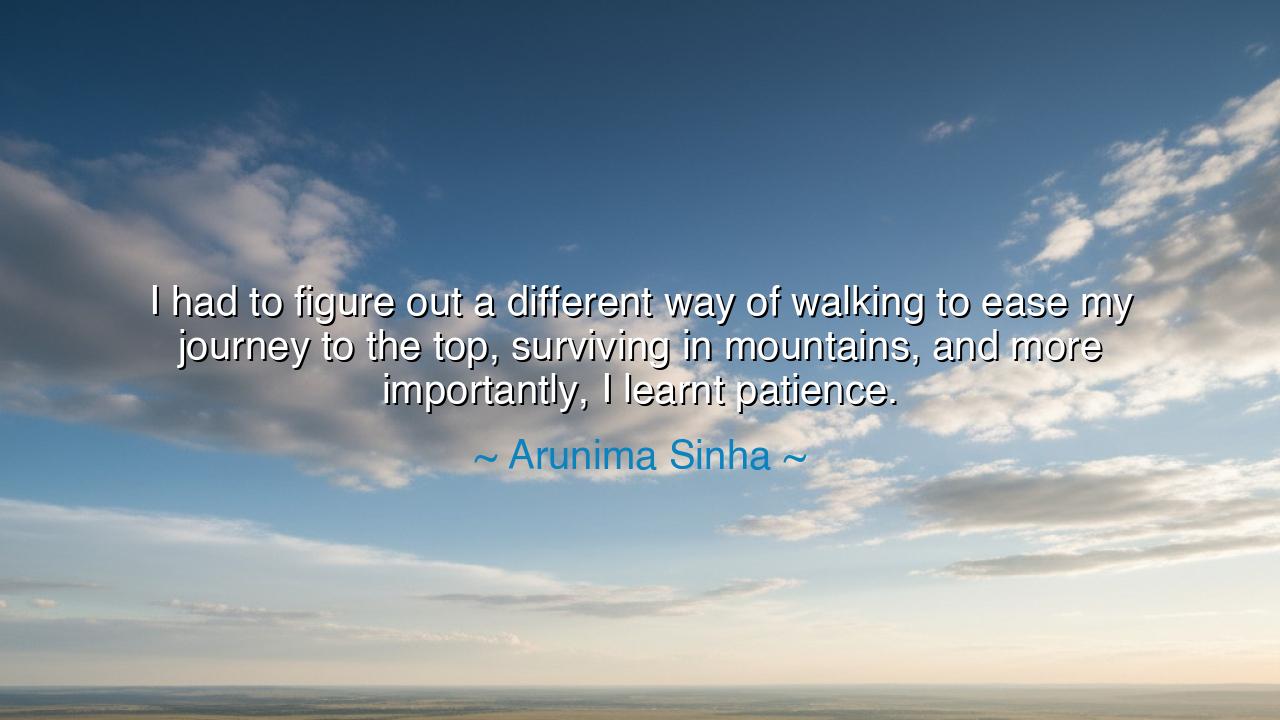
I had to figure out a different way of walking to ease my
I had to figure out a different way of walking to ease my journey to the top, surviving in mountains, and more importantly, I learnt patience.






Hear now the powerful words of Arunima Sinha, who declared: “I had to figure out a different way of walking to ease my journey to the top, surviving in mountains, and more importantly, I learnt patience.” These are not the musings of one who walked a smooth road, but the testimony of a warrior of life, who rose from tragedy to triumph. Each word shines with the weight of trial and the fire of endurance, for she speaks not of comfort, but of the discipline that transforms suffering into strength.
When she speaks of a new way of walking, she reveals the eternal truth that every path to greatness demands adaptation. The straight road may not always lie before us; sometimes it is broken, uneven, or steep. For Sinha, who lost a leg in a cruel accident yet chose to climb the highest peaks, this was no mere metaphor—it was literal. She had to teach her body a new rhythm, to carve out a new method for moving forward. In this, she teaches us all that when life changes our form, we must change our stride, yet never cease our journey.
Her mention of the journey to the top speaks not only of mountains of stone but of mountains of destiny. The summit she sought was Mount Everest, but beyond it lay the greater summit of proving to herself and the world that human will can conquer even the harshest fate. This journey is one all must walk in their own way, whether through trials of body, heart, or spirit. To climb is to live; to refuse is to wither. The top is not only a peak in the clouds, but the realization of one’s own highest self.
The mountains she names are symbols of life’s greatest struggles. They are vast, cold, and unyielding, yet they call forth courage from those bold enough to face them. In history, Hannibal crossed the Alps to challenge Rome, and his march became a legend of audacity. Yet Arunima’s climb was greater still, for she fought not against armies but against despair itself. Each step was a declaration: “I will not be defeated.” Thus her mountains are not only of ice and rock, but of doubt, pain, and limitation, conquered by spirit.
And then she reveals the greatest treasure of all: she learnt patience. For the summit is never reached in haste. A climber who rushes is doomed; only the steady heart, the deliberate step, and the waiting spirit can endure the thin air and the biting winds. Patience, in her words, is not passive. It is the most active of powers—the ability to persist day after day, to accept that progress may be slow, but still to believe in the goal. Her triumph was not in the single moment of planting a flag on Everest’s peak, but in the countless moments of quiet endurance that led her there.
The origin of her words lies in the crucible of suffering and rebirth. Once a national athlete, she was cast down by tragedy, thrown beneath a train in an act of violence that left her broken. Yet instead of surrendering, she rose anew, transformed her pain into resolve, and became the first female amputee to scale Mount Everest. Her life itself is the soil from which these words grow, watered by hardship and nourished by hope.
The lesson for us is plain and eternal: when life changes your path, do not cease walking—find another way. When the summit feels far, do not lose heart—focus on the step before you. When trials rise like mountains, do not curse them—climb them, and they will reveal your strength. And above all, cultivate patience, for without it, no dream endures.
Practical action is simple yet profound: in your own struggles, break the journey into steps. Do not demand instant victory, but honor the process of growth. When obstacles arise, adapt, as Sinha did with her walk. When despair whispers, remember that even the tallest mountain is climbed one step at a time. And when you stand at last upon your summit, know that the true triumph was not only the view, but the patience that carried you there. Walk, climb, endure—learn patience, and you shall conquer.






AAdministratorAdministrator
Welcome, honored guests. Please leave a comment, we will respond soon